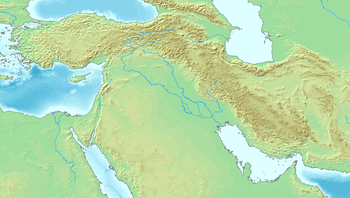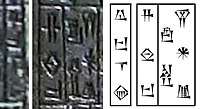Manishtushu Obelisk
The Manishtushu Obelisk is a diorite, four-sided stele. The stele is obelisk-shaped, as well as it narrows upward to its (damaged) top, in a pyramidal-form. The obelisk was erected by Manishtushu, son of Sargon the Great, of the Akkadian Empire, who ruled circa 2270–2255 BC.
| Manishtushu Obelisk | |
|---|---|
Manishtushu Obelisk, Louvre Museum | |
| Material | Diorite |
| Created | 2270–2255 BC |
| Discovered | Susa |
| Present location | Louvre Museum, Paris |
| Registration | Sb 20[1] |
The Manishtushu Obelisk, created under the Akkadian Empire in Mesopotamia circa 2270–2255 BC, was taken as booty to Susa in the 12th century BC. | |
As a spoil of war, the stele was taken to Susa by the Elamite king Shutruk-Nakhunte in the 12th century BC.
Description and purpose
The Manishtushu Obelisk is 1.4 m tall, and 0.6 m wide[2] on its four sides. It is made of deep black diorite, and incised in Akkadian language cuneiform in horizontal rows on all sides. The cuneiform is written within 1519 boxes, as lined registers. The material was imported into Sumeria from Magan – today the area covered by the United Arab Emirates and Oman,[3] and on clay tablets Manishtushu recorded: "From mountains beyond the 'lower sea' (Persian Gulf), he took black stones; he loaded [them] on boats and docked [them] on the quay at Akkad. He fashioned his statue [and] dedicated [it] to Enlil."[4]
The obelisk text is a legal record that records the distribution of four parcels of land, in large estates, and its allotment to his officers, for his control of Kish.[5]
Ilshu-rabi
The name of Ilšu-rabi as Governor of Pashime appears in the Manishtushu Obelisk inscription, in several mentions of his son Ipulum, who is said to be:
(𒌉) 𒀭𒋢𒊏𒉈 𒑐𒋼𒋛 𒁀𒋛𒈨𒆠
(dumu) il-su-ra-bi2 ensi2 ba-si-me{ki}
"(Son of) Ilshu-rabi, Governor of Pashime"
References
- "Maishtushu Obelisk".
- Manishtusu Obelisk, Louvre Museum
- RAGOZIN, ZENAIDE A. (2017). STORY OF CHALDEA FROM THE EARLIEST TIMES TO THE RISE OF ASSYRIA : treated as a general ... introduction to the study of ancient history. [Place of publication not identified]: FORGOTTEN Books. p. 209. ISBN 978-1330342589. OCLC 990104817.
- Manishtusu Obelisk, Louvre
- Manishtusu Obelisk, Louvre
- Manishtushu Obelisk Column 15 Lines 15-16-17 d-su-ra-bi2 ensi2 ba-si-me{ki} "CDLI-Found Texts". cdli.ucla.edu.
- Eppihimer, Melissa (2019). Exemplars of Kingship: Art, Tradition, and the Legacy of the Akkadians. Oxford University Press. p. 222. ISBN 978-0-19-090301-5.
- "Tell Abu Sheeja/ Ancient Pashime" (PDF). Cite journal requires
|journal=(help) - "CDLI-Found Texts". cdli.ucla.edu.
- "CDLI-Found Texts". cdli.ucla.edu.



